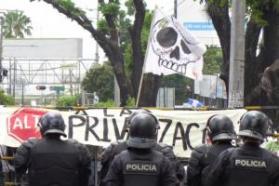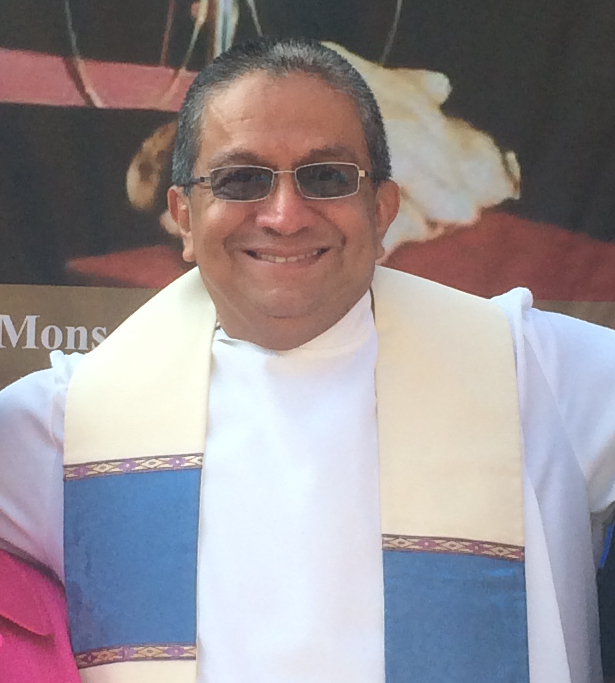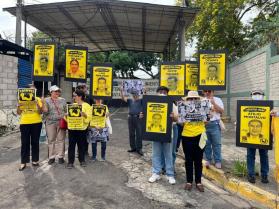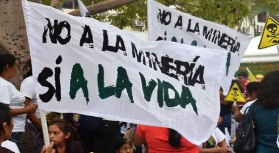East Coast CISPES Chapters Share Skills at Regional Training
by Eli Latto, Boston CISPES
On a Saturday morning in early December, in a basement roomof the Borough of Manhattan Community College, twenty-five people in socks sitin a circle of desks. A girl holds up a pair of Doc Martens shoes, examiningthem for clues as to who their owner might be.
It’sthe first day of the CISPES East Coast Regional Training, and I’ve only beenthe Chapter Coordinator of Boston CISPES for two months. Last night, the othercommittee members and I drove four hours to convene with New York CISPES,National Office staff members and the newly-formed D.C. CISPES, for our firstannual East Coast regional training. The goal of the weekend is to educateourselves about our anti-mining campaign: the ins and outs of the Pacific Rimlawsuit, strategy, and analysis. But first, we’ve got to get to know each other– which is where the opening dinámica with the shoes comes in.
Aftera breakfast of New York bagels and coffee, Julia Kaminsky from New York speaksabout her experience living in Cabañas, El Salvador, working with communityorganizations opposed to mining. I am struck by the hardships and resistanceshe bore witness to, as well as the clarity of her analysis. Marcelo Rivera,the activist who was assassinated in June of 2009, was her boss. In that momentMarcelo becomes not another name to me but a real person: a man with a family,who was killed for trying to protect his community. Our campaign starts to takeon new urgency in my eyes.
Nowthat the why of our anti-mining campaign is clear, it's time to talk about how.Mackenzie Baris and Sara Wallace-Keeshen from D.C. facilitate a hands-oncampaign strategy session, going over different types of targets, tactics, andobjectives. It’s obvious that these skills are translatable to many differenttypes of activism, and in true CISPES fashion, everyone has a role to play.
OnSaturday night we host a public panel, “We Say No To Mining!,” with AvivaChomsky, Sakura Saunders, anti-mining activist and editor ofprotestbarrick.net, Leandra Requena from Peruvians in Action, and JuliaKaminsky. Although everyone is exhausted after such a long day, it’s great tohear about anti-mining struggles from Canada to Colombia – one CISPista eventells me it’s one of the best panels she’s been to.
Thenext day, we reconvene for workshops on anti-oppression organizing, mediatactics, and how to use social media to promote a campaign. While eatinghomemade pupusas for lunch after a jam-packed morning, I talk with others abouthow and why they got involved with CISPES. The diversity of backgrounds isstriking: there are labor organizers, college students, youth workers, computerprogrammers. Many people talk about their experiences in El Salvador – whetherit was a delegation that solidified their commitment or whether they foundCISPES after returning to the States from Central America, it’s clear that thisone country is a special place for many. Andrew Kessel from Boston and I lookat each other and both know: “We’ve gotta go to El Salvador.”
FranciscoRodriguez and I co-facilitate the last workshop of the day: “Making MotivatingMining Presentations.” Francisco, Alana Epstein, and I planned the workshoptogether, and although I was nervous initially, I feel a lot more comfortablewith this crowd after spending the whole weekend together. Everyone is loosenedup and more than ready to participate in our “mining bingo” game, whichexplains how to talk about the campaign in a brief conversation.
Carpoolingback to Boston that night I am exhausted, but also inspired by all thepositive, productive energy of the weekend. With our shoes back on our feet,it’s time to hit the ground running

 "I am a CISPES supporter because continuing to fight for social justice and a more people-centered country means continuing the dream and sacrifice of thousands of my fellow Salvadorans who died for that vision.” - Padre Carlos, New York City
"I am a CISPES supporter because continuing to fight for social justice and a more people-centered country means continuing the dream and sacrifice of thousands of my fellow Salvadorans who died for that vision.” - Padre Carlos, New York City

